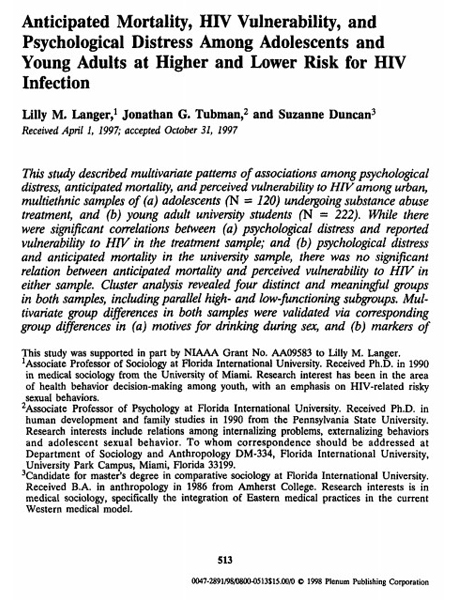Anticipated mortality, HIV vulnerability, and psychological distress among adolescents and young adults at higher and lower risk for HIV infection
 Abstract: This study described multivariate patterns of associations among psychological distress, anticipated mortality, and perceived vulnerability to HIV among urban, multiethnic samples of (a) adolescents (N = 120) undergoing substance abuse treatment, and (b) young adult university students (N = 222). While there were significant correlations between (a) psychological distress and reported vulnerability to HIV in the treatment sample; and (b) psychological distress and anticipated mortality in the university sample, there was no significant relation between anticipated mortality and perceived vulnerability to HIV in either sample. Cluster analysis revealed four distinct and meaningful groups in both samples, including parallel high- and low-functioning subgroups. Multivariate group differences in both samples were validated via corresponding group differences in (a) motives for drinking during sex, and (b) markers of serious psychological distress (e.g., suicidal thoughts and attempts). The findings challenge popular sterotpes of adolescents’ perceptions of their own mortality and vulnerability to HIV and may have significant implications for the planning and implementation of effective HIV preventions among at-risk youth.
Abstract: This study described multivariate patterns of associations among psychological distress, anticipated mortality, and perceived vulnerability to HIV among urban, multiethnic samples of (a) adolescents (N = 120) undergoing substance abuse treatment, and (b) young adult university students (N = 222). While there were significant correlations between (a) psychological distress and reported vulnerability to HIV in the treatment sample; and (b) psychological distress and anticipated mortality in the university sample, there was no significant relation between anticipated mortality and perceived vulnerability to HIV in either sample. Cluster analysis revealed four distinct and meaningful groups in both samples, including parallel high- and low-functioning subgroups. Multivariate group differences in both samples were validated via corresponding group differences in (a) motives for drinking during sex, and (b) markers of serious psychological distress (e.g., suicidal thoughts and attempts). The findings challenge popular sterotpes of adolescents’ perceptions of their own mortality and vulnerability to HIV and may have significant implications for the planning and implementation of effective HIV preventions among at-risk youth.
Langer, L.M., Tubman, J.G., & Duncan, S. (1998). Anticipated mortality, HIV vulnerability, and psychological distress among adolescents and young adults at higher and lower risk for HIV infection. Journal of Youth and Adolescence, 27(4), 513-538. doi:10.1023/a:1022856203755
